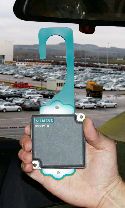BMW Group has installed Siemens’ real-time location (RTL) system at its manufacturing plant in Dingolfing, Germany. The RTL system, which uses technology from WhereNet, lets BMW workers instantly locate and track any vehicle as it comes off the assembly line or is moved to one of 3,000 parking spaces on the factory premises.
In March, WhereNet announced Siemens Automation and Drives Group had adopted WhereNet’s technology, making it part of Siemens’ RFID product line, MOBY-R. Called Sicalis RTL, the rebranded WhereNet solution enables businesses to track merchandise, trucks, parts and other items as they move about a given area.
Using Sicalis, BMW is able to distinguish each of its vehicles leaving the plant’s assembly line. To enable that, each vehicle must be equipped with a data carrier. The carrier, which contains a battery-powered RFID tag, can be attached to the vehicle’s inside rear-view mirror with a special hanger. The data carrier transmits an ID number to RFID access points (RFID reader antennas) installed throughout the facility. Ford Motor Co. and other WhereNet customers use the same technology to track cars as they roll off the assembly line.
The MOBY-R system, such as the one deployed at BMW plant, uses WhereNet’s WhereLAN Location Sensor and Locating Access Point technology to create a wireless network within a facility. Mobile workers can access information using WhereNet’s Wi-Fi infrastructure. Once users have configured the data carriers to transmit their IDs at set times and attached the carriers to the desired assets, the system will start tracking those assets. For indoor facilities, the access points are installed 250 to 350 feet apart. When deployed outdoors, access points are installed 750 to 1,000 feet apart.
WhereNet’s programmable active tags use a 2.4 GHz frequency band. The receivers can locate a tag within 10 feet. The tag’s location data is then stored in an SQL database. The technology will also let users track and manage information about the assets. For example, if the tags were deployed on a refrigerated car, a user might be able query the device to see if the car is a certain temperature or if the door is closed or open.
BMW lets its employees access vehicle-location data on a company intranet via a Web browser. The application displays the location of the cars in a graphic format. Prior to implementing the Sicalis system, BMW had to track its vehicles manually, according to Dan Doles, president and CEO for WhereNet, which is based in Santa Clara, Calif. Doles says WhereNet has deployed RFID systems at more than 50 auto plants worldwide. The goal of the BMW deployment is to reduce the carmaker’s finished-goods inventory by improving throughput.
“They don’t want to have their cars at the factory any longer then they have to,” says Doles. The system may reduce labor costs by eliminating manual processing of the vehicles as well, according to Doles.
Siemens worked to integrate and deploy the Sicalis system for BMW. Typical deployment time is between 60 and 90 days. Pricing for WhereNet’s products depends on the application, coverage area and number of assets tracked.


